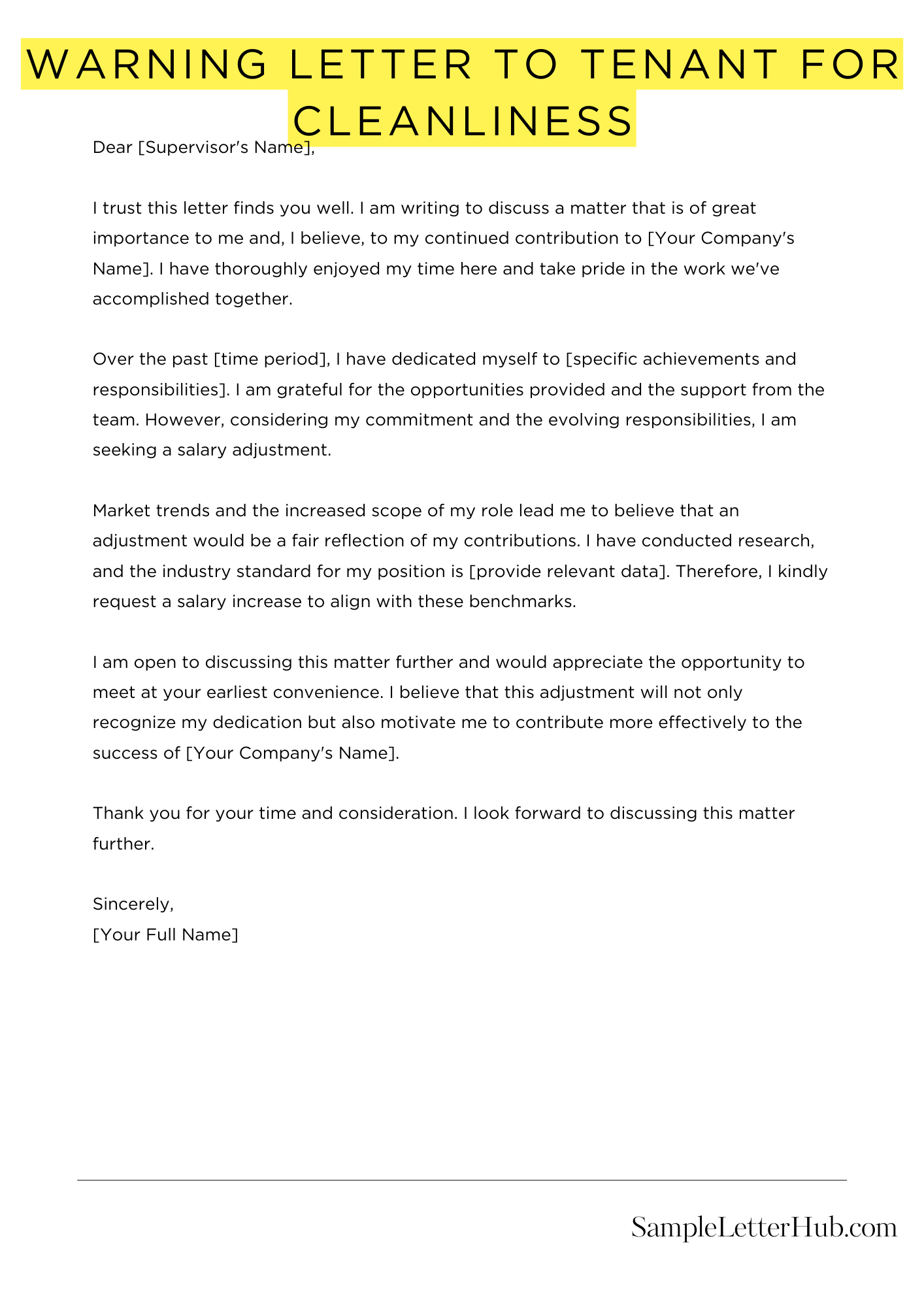A warning letter to a tenant for cleanliness is a formal notice issued by a landlord to address unsatisfactory levels of cleanliness and hygiene in a rental property. It outlines the specific issues that need to be addressed, provides a timeline for corrective action, and outlines the potential consequences of non-compliance.
In this article, we’ll provide you with a collection of templates, examples, and samples of warning letters to tenants for cleanliness. These letters are designed to help you effectively communicate your concerns, document the situation, and encourage your tenant to take prompt action to improve the cleanliness of the property.
Warning Letter To Tenant For Cleanliness
Dear [Tenant Name],
This letter serves as a formal warning regarding the unsatisfactory cleanliness of the rental property located at [Property Address].
During a recent inspection, it was observed that the property was in an unacceptable state. Specifically, the following areas were found to be neglected:
* [List of specific areas, e.g., kitchen, bathroom, floors]
These conditions violate the terms of your lease agreement, which requires you to maintain the property in a clean and habitable condition.
The accumulation of dirt, debris, and unsanitary conditions not only poses health and safety hazards but also diminishes the value of the property. It is imperative that you take immediate action to address these issues.
Within seven (7) days of receiving this notice, you are required to:
* Thoroughly clean and disinfect all affected areas
* Remove all trash and debris from the property
* Address any underlying causes of the uncleanliness, such as pests or plumbing issues
Failure to comply with these requirements within the specified timeframe may result in further action, including:
* Additional fines
* Eviction proceedings
We understand that life can be busy, but maintaining a clean and healthy living environment is a fundamental responsibility of tenancy. We urge you to prioritize this matter and take the necessary steps to rectify the situation.
If you have any questions or require assistance, please do not hesitate to contact us.
Sincerely,
[Your Name]

How to Write a Warning Letter to a Tenant for Cleanliness
Maintaining a clean and habitable living space is essential for the health and well-being of tenants. However, there may be instances where a tenant’s cleanliness habits fall short of the expected standards, necessitating the issuance of a warning letter.
Assess the Situation
Before drafting a warning letter, it is crucial to thoroughly assess the situation. Document any instances of uncleanliness, such as unkempt common areas, excessive clutter, or unsanitary conditions. Take photographs or videos as evidence if possible.
Communicate Clearly
The warning letter should be clear and concise, outlining the specific areas of concern. Use specific examples and avoid vague or general language. For example, instead of stating “the apartment is dirty,” write “the kitchen floor has not been cleaned in several weeks.”
Provide a Deadline
Set a reasonable deadline for the tenant to address the cleanliness issues. This deadline should be specific and provide ample time for the tenant to make the necessary improvements.
Offer Support
While the letter should convey the seriousness of the situation, it is also important to offer support to the tenant. Suggest resources or assistance that may help them improve their cleanliness habits, such as a cleaning service or a referral to a social worker.
Consequences of Non-Compliance
Explain the potential consequences of non-compliance with the warning letter. This may include fines, eviction, or other legal action. However, it is important to note that the consequences should be proportionate to the severity of the cleanliness issues.
Keep a Record
Maintain a record of all communication with the tenant regarding the cleanliness issues. This may include copies of the warning letter, emails, or any other correspondence. This documentation will be valuable if further action is required.
Follow Up
After the deadline has passed, follow up with the tenant to assess their progress. If the cleanliness issues have been resolved, acknowledge the tenant’s efforts and thank them for their cooperation. If the issues persist, consider further action, such as issuing a formal notice of violation or initiating legal proceedings.
FAQs about Warning Letter To Tenant For Cleanliness
What is a warning letter to a tenant for cleanliness?
A warning letter to a tenant for cleanliness is a formal notice that is sent to a tenant who has not been keeping their rental unit clean. The letter will typically outline the specific areas that need to be cleaned, and will give the tenant a deadline to complete the cleaning.
What are the most common reasons for sending a warning letter to a tenant for cleanliness?
The most common reasons for sending a warning letter to a tenant for cleanliness include:
- Excessive dirt and grime
- Unclean bathrooms and kitchens
- Pet waste
- Hoarding
- Mold and mildew
What should be included in a warning letter to a tenant for cleanliness?
A warning letter to a tenant for cleanliness should include the following information:
- A statement that the tenant is in violation of their lease agreement
- A description of the specific areas that need to be cleaned
- A deadline for completing the cleaning
- A statement of the consequences if the tenant does not comply
What are the consequences of not complying with a warning letter to a tenant for cleanliness?
If a tenant does not comply with a warning letter to a tenant for cleanliness, the landlord may take further action, such as:
- Issuing a fine
- Evicting the tenant
How can I avoid getting a warning letter to a tenant for cleanliness?
To avoid getting a warning letter to a tenant for cleanliness, tenants should:
- Keep their rental unit clean and free of dirt and grime
- Clean their bathrooms and kitchens regularly
- Dispose of pet waste properly
- Avoid hoarding
- Address any mold or mildew problems immediately

